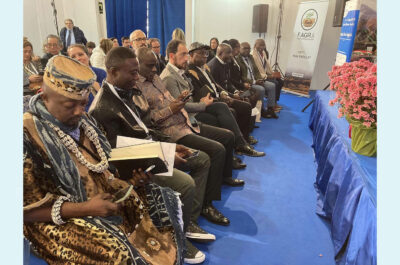The eco-tourism and safari holiday industry has taken this melting pot of cuisine a step further, incorporating local free-range venison and indigenous vegetables like madumbi(similar to a yam or sweet potato) and morogo(wild spinach) into both traditional favourites and new creations.
The “safari cuisine”created in luxury game lodges across Africa is rapidly emerging as a distinctive style of cooking from the continent, cutting across country borders and cultural barriers.
Blending the indigenous and the contemporary, African with Western and Asian, the fusion-style menus created by chefs at game reserves and wildlife retreats are putting African food on the map – this from a continent that has previously lacked a distinctive culinary style.
The American chef and food writer James Beard described food as “our common ground, a universal experience”. Those who have been on an African bush holiday know that food around a campfire, combined with the back-to-nature experience, has the power of a common language.
Africa is arguably the most-colonised continent and its cuisine – like its languages – draws on diverse influences alongside indigenous ingredients and methods, from Arab, Malay and Indian, to English, Dutch, French, German and Portuguese.
Across the continent, indigenous ingredients and colonial heritage are meeting the formal skills of young and dynamic chefs, determined to offer guests a five-star experience in the wilds of the African bush, despite lacking the state-of-the-art kitchens of their counterparts in London and Paris.

South Africa is no exception to this trend. Although its top restaurants and hotels may excel at Western-style fine dining, many also draw on the rich culinary heritage resulting from waves of colonisation and immigration since the Dutch landed in 1652. Along with the Dutch and English colonial masters, came immigrants from Germany, France, Italy, Greece and Portugal, and Indian and Asian slaves and servants.
The result is a rich cultural hot-pot of diverse flavours from spicy to sweet, a love of all things meaty, the bountiful produce of the oceans, and more recently incorporating the cooking of the indigenous Nguni and Sotho people.
The eco-tourism and safari holiday industry has taken this melting pot of cuisine a step further, incorporating local free-range venison and indigenous vegetables like madumbi(similar to a yam or sweet potato) and morogo(wild spinach) into both traditional favourites and new creations. Travellers delight in the locally-sourced, traditionally-influenced dishes often served under the stars around a campfire or braai (barbecue) in a boma (bush enclosure) or out in the bush, with the only music the roar of distant lions and chirping night insects.
“That experience is a distinct part of the enjoyment of the food, and of the whole safari experience – hearty meals cooked outdoors, good company, superb South African wines, the stars and the sounds of the bush, all combine to create a truly memorable experience for guests,” says Linda Keevy, chef at Lalibela Game Reserve in the Eastern Cape province of South Africa.
As author and social critic Barbara Ehrenreichnotes, in the electronic age mediated by computer and TV screens, food “may be the only sensual experience left.”
Guests at Lalibela Game Reserve are likely to find themselves enjoying a roasted Springbok loin rather than Kobe or Argentinian beef at dinner time, and warthog sausages instead of their favourite porkies at breakfast time.
As a side dish with their braai (barbecue), guests tuck into Lalibela’s trademark “squamba” – a salad of morogo(wild spinach) and mielie-meal pap (maize meal porridge) that echoes dishes such as an Italian polenta and spinach.
“The tomatoes in the salad might not be perfectly symmetrical but they are grown organically on the farm next door to Lalibela, picked fresh this morning, and will taste more like a tomato than any other you’ve ever eaten,” says Keevy.
And that is part of the charm of an eco- and game-based holiday – eating fresh, local produce as the locals might, but with an innovative and creative twist. This is food made by chefs who have learnt to make do, to improvise with pineapple leaves as garnish when the African heat makes mint wilt, and to return to their roots by using fire in diverse ways to cook everything from bread to vegetables, meat main courses to desserts.
Even traditional local dishes like bobotie – a spiced mince topped with a savoury egg custard – are given the bush-twist by being made with locally-farmed, organic and free-range venison – and they’re a huge hit with visitors to the Big 5 Lalibela reserve.
After several hours on a game-viewing vehicle tracking rhino and elephant, a hearty venison pie or slow-roasted Springbok shoulder are most welcome.
“We make hearty food – not towers on a plate,” says Keevy.
She and her team of cooks use what’s in season, what’s locally available, and adapt to their cooking facilities – whether it’s on gas in the kitchen or on a fire in the bush enclosure – to ensure guests leave Lalibela feeling that they’ve not only seen, but also tasted Africa.
Tatiana is the news coordinator for TravelDailyNews Media Network (traveldailynews.gr, traveldailynews.com and traveldailynews.asia). Her role includes monitoring the hundreds of news sources of TravelDailyNews Media Network and skimming the most important according to our strategy.
She holds a Bachelor's degree in Communication & Mass Media from Panteion University of Political & Social Studies of Athens and she has been editor and editor-in-chief in various economic magazines and newspapers.





























































































































































































